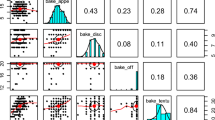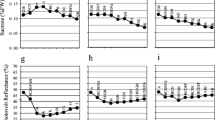Abstract
Variability in specific gravity of Russet Burbank potatoes was documented in a single 32 hectare field. Maximum variation was 40 units among individual tubers within hills (one unit equals one part in 1000th of specific gravity measurement) and 15 units among hills. Field site variability of 10–15 units was common between sampled grid lines in the field; but bulked samples (truckloads) reduced the sampled variability to 8–10 units. When the samples were taken from bulked lots as opposed to single hill samples, the variability decreased. Grower lots, which were pooled samples from several truckloads, showed specific gravity differences of 2–7 units even though all lots were from the same field. These variations among specific gravity samples should be taken into account when considering total solids content in any lot of potatoes.
Degree of russetting of the skin and hollow heart also influenced specific gravity measurements. Measured differences between peeled and unpeeled lots of 10 units in specific gravity corresponded to 2% difference in total solids content. Statistically, the variance of the peeled lot was one half that of the unpeeled lot, therefore, to minimize the measured differences due to skin type, peeled potatoes could be used for the specific gravity measurements.
Compendio
Se probó la variabilidad en la gravedad específica de las papas Russet Burbank en un solo campo de 32 hectáreas. La variación máaxima entre tubérculos individuales dentro de los puntos de siembra fue de 40 unidades (una unidad es igual a una parte por milésimo de la gravedad específica medida) y 15 unidades entre puntos de siembra. Fue común encontrar una variabilidad de 10–15 unidades entre las diferentes muestras tomadas en el terreno convenientemente dividido; pero muestras al granel (camionadas) redujeron la variabilidad de las muestras a 8–10 unidades. Cuando las muestras fueron tomadas de lotes al granel en oposición a muestras de un solo golpe o punto de siembra, la variabilidad disminuyó. Los lotes de los productores, que fueron una mezcla de muestras tomadas de varias camionadas, mostraron diferencias de 2–7 unidades en la gravedad específica aún en el caso que todos los lotes fueran del mismo campo. Estas variaciones en las muestras, en cuanto a gravedad específica, deben tomarse en cuenta cuando se considere el contenido total de sólidos en cualquier lote de papas.
El grado de reticulado de la piel y el de corazón vacío influencian también las mediciones de la gravedad específica. Las diferencias en las mediciones de la gravedad específica entre lotes pelados y sin pelar, que fueron de 10 unidades, corresponden a un 2% de diferencia en el contenido de sólidos totales. Estadísticamente, la variancia de los lotes pelados fue la mitad que la de los lotes sin pelar, por lo tanto, para minimizar las diferencias en las mediciones, debidas a las condiciones de la piel, se podrian usar papas peladas para las medición de la gravedad específica.
Similar content being viewed by others
Literature Cited
Agle, William and G.W. Woodbury. 1968. Specific gravity — dry matter relationship and reducing sugar changes affected by potato variety production area and storage. Am Potato J 45:119–131.
Drew, J.P. and D. Deasy. 1941. Hollow heart. J Dep Agric Repub Irl 38:220–238.
Iritani, W.M., W.C. Sparks and W.H. Weinheimer. 1963. Factors affecting the accuracy of specific gravity determinations. Idaho Agric Exp Stn Progress Report 66.
Kleinkopf, G.E., D.T. Westermann and M.J. Wille. 1985. Specific Gravity: Proceedings of the University of Idaho Winter Commodity Schools 17:162–166.
Murphy, H.J. and M.J. Goven. 1959. Factors affecting specific gravity measurements, dry matter contents and weight of fresh potato tubers. Am Potato J 36:6–9.
Nissen, M. 1955. The weight of potatoes in water. Am Potato J 32:332–339.
Porter, W.L., T.J. Fitzpatrick and E.A. Talley. 1964. Studies of the relationship of specific gravity to total solids of potatoes. Am Potato J 41:329–336.
Saini, G.R. 1964. Determination of dry matter in potatoes. Am Potato J 41:123–125.
Sharma, M.K., D.R. Isleib and S.T. Dexter. 1958. Specific gravity of different zones within potato tubers. Am Potato J 35:784–788.
United States Department of Agriculture. 1983. United States Standards for grades of potatoes for processing. 48 FR 10801. Revised, effective April 14, 1983.
Von Scheele, C. 1937. Die bestimmung des starkghelts und der trockensubstanz der kartoffel mit hilfe des specifischen gewichte. Landw Ver Stn 127:67–96.
Woodbury, G.W. and W.H. Weinheimer. 1965. Specific gravity — solids correlations in Russet Burbank with respect to point of origin and storage history. Am Potato J 42:98–104.
Author information
Authors and Affiliations
Additional information
Supported by the University of Idaho, College of Agriculture, Moscow, Idaho, the USDA Agricultural Research Service, Kimberly, Idaho 83341, and the Idaho Potato Commission.
Rights and permissions
About this article
Cite this article
Kleinkopf, G.E., Westermann, D.T., Wille, M.J. et al. Specific gravity of Russet Burbank potatoes. American Potato Journal 64, 579–587 (1987). https://doi.org/10.1007/BF02853760
Accepted:
Issue Date:
DOI: https://doi.org/10.1007/BF02853760




